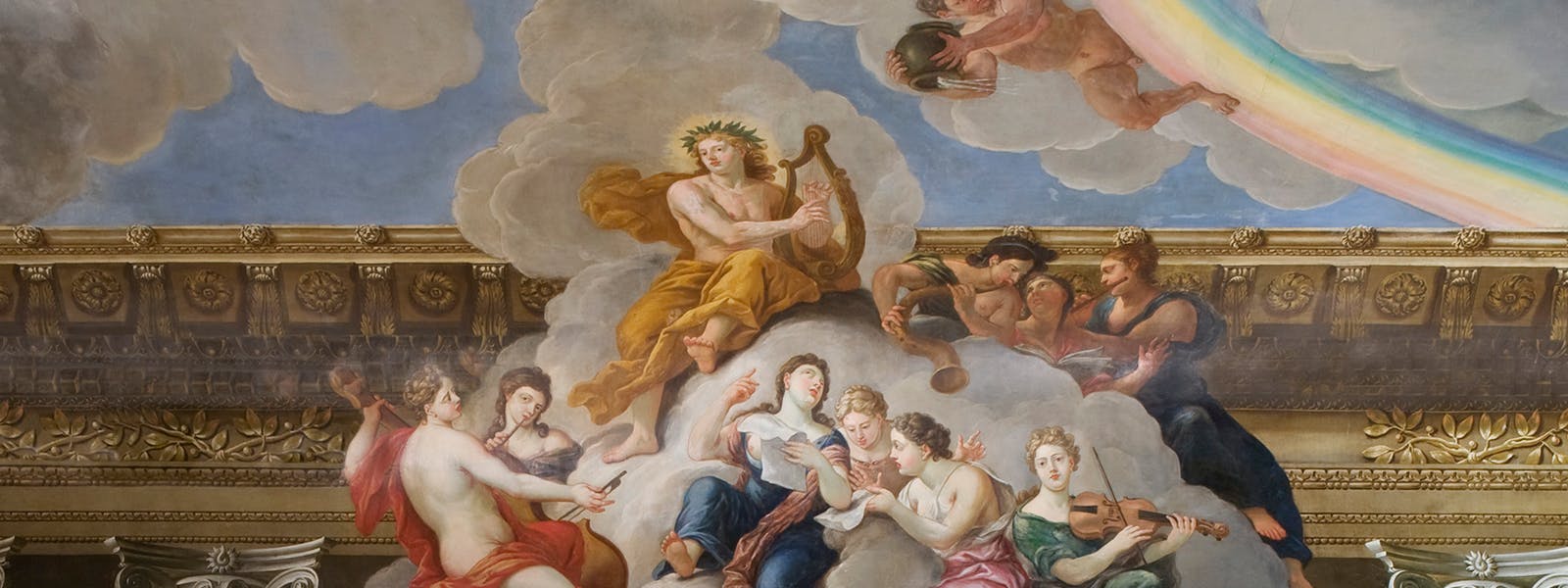
LGBT+ histories can be found in the stories of all our palaces. However, same-sex love and desire and non-binary gender identities have been understood in different ways throughout history. Our modern understanding of Lesbian, Gay, Bisexual and Trans identities are very recent, dating from the late 19th Century and continuing to develop up to the present day.
When we try to look for these identities in the past we struggle, but if we look for love, desire, and the way people presented themselves, we find a rich history everywhere. People in the past saw sexuality as something you did, rather than something you were. Stories abound of people dressing and living their lives in ways that crossed the gender boundary of male and female. We sometimes use a ‘+’ as part of ‘LGBT+’ or the word ‘queer’ to represent the many ways people lived their lives.
Here are a few queer lives from our palace’s histories.
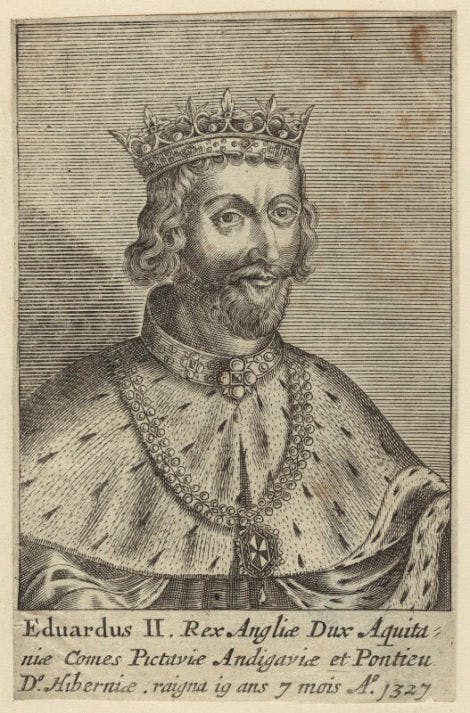
Image: Edward II, © National Portrait Gallery, London
Edward II
Edward II (1307-37) used the Medieval Palace at the Tower of London. The King and his favourite, his closest political and emotional ally, Piers Gaveston, are often thought to have been lovers.
The truth will never be known, as medieval chroniclers didn’t record what happened between the two men behind closed doors. They did comment on the exceptional closeness of the relationship, recording the strength of Edward’s love for Gaveston when they first met in in about 1297.
Their love is often described at the time in fraternal terms, and they may have entered into a bond as ‘wed brothers’ or a ‘Bond of Brotherhood’.
Edward never had a mistress, and even at his wedding banquet the King is said to have given more attention to Gaveston than to his new Queen.
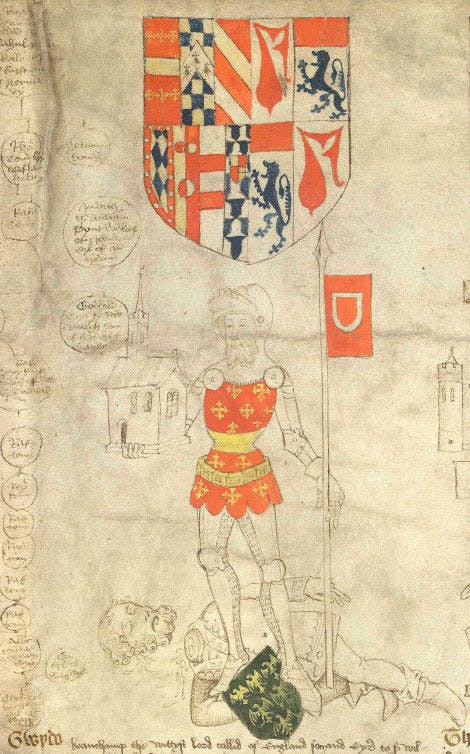
Image: The Rous Roll c 1483 (detail). Guy Beauchamp, Earl of Warwick, in chain-mail, armour and a tabard bearing his coat of arms, holding a church in his right hand and a banner in his left hand, trampling the decapitated Piers Gaveston under his feet. © British Library Board MSS 48976
'An unbreakable bond of love'
This was how the first meeting of Edward II and Piers Gaveston was described in the Chronicle of the Civil Wars of Edward II:
'When the king’s son gazed upon him, he straightaway felt so much love for him that he entered into a covenant of brotherhood with him and chose and firmly resolved to bind himself to him, before all mortals, in an unbreakable bond of love.'
The power and titles Edward gave to Gaveston meant the royal favourite was deeply unpopular, and he was executed by a group of nobles on 19 June 1312.
We may never know
While we will never know the truth of Edward’s sexuality, it has been speculated about for centuries. Christopher Marlowe’s 1592 play Edward II, suggests that Edward could be pleased by a ‘lovelie boye’, and queer filmmaker Derek Jarman adapted the play to comment on the lives of gay men in 1980s Britain.
Recent films, books and even the contemporary opera Lessons in Love and Violence, have portrayed Edward II and Gaveston as gay lovers, a label that did not exist when they lived. Each generation relates Edward’s life to its own experiences.
Did you know?
Accusations of same-sex desire were used to discredit the reputations of monarchs.

Image: James I and VI c. 1620. Royal Collection Trust / © Her Majesty Queen Elizabeth II 2018
James VI and I
James VI and I (r 1603-25) built the Banqueting House. He is immortalised in Rubens's ceiling paintings.
James loved men throughout his life. He bestowed power and aristocratic titles on his favourites, and powerful families would send their sons to court to gain favour with the King.
James was 13 when he met his first favourite, Esmé Stewart, who was 37. Stewart became a mentor to the young king.
When James was older, he formed relationships with handsome younger men whom he could mentor. He fell for the blond athlete, Robert Carr, Earl of Somerset, at a joust in 1607.
However, an ill-advised marriage, imprisonment at the Tower of London, and a sensational murder trial, saw Carr fall from favour.
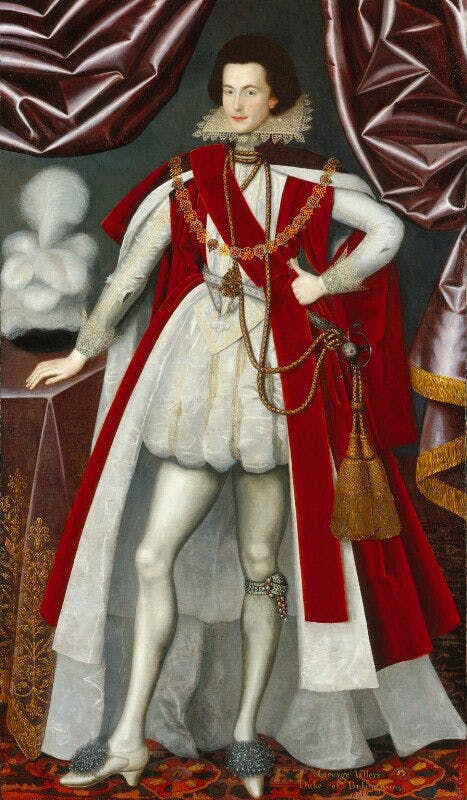
Image: George Villiers, 1st Duke of Buckingham attributed to William Larkin, and studio of William Larkin, circa 1616. © National Portrait Gallery, London
'The handsomest bodied man of England'
James met George Villiers in 1614, perhaps because his wife, Queen Anne of Denmark, and other courtiers, wished to replace the disgraced Robert Carr in James’s affections.
Bishop Godfrey Goodman described Villiers as ‘the handsomest bodied man of England…and so sweet of disposition’. Villiers rose to become Duke of Buckingham, and with the favour of the King, was a powerful man.
James wrote in a letter to Villiers:
‘There is this difference betwixt that noble hand and heart, one may surfeit by the one, but not the other, and sooner by yours than his own; therefore give me leave to stop, with mine, that hand which hath been too ready to execute the motions and affections of that kind of obliging heart to me’.
George Villiers and Charles I
George Villiers maintained his power into the reign of James’s son, Charles I, and Charles and Villiers are shown in the painting Apollo and Diana hanging on the Queen’s Stairs at Hampton Court Palace.
In this painting, Charles I (Apollo) and his wife Henrietta Maria (Diana) are seated together. The sitter playing Mercury is Villiers, the Duke of Buckingham with his wife by his side. The two men gaze intently at each other, neither paying much attention to their spouses.

Image: Apollo and Diana by Gerrit van Honthorst. Royal Collection Trust / © Her Majesty Queen Elizabeth II 2017.
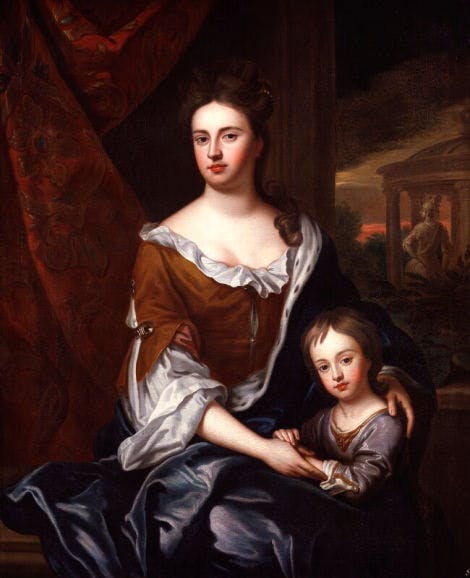
Image: Queen Anne and her eldest son William, Duke of Gloucester, studio of Sir Godfrey Kneller. © National Portrait Gallery, London
Queen Anne
Queen Anne (r 1702-14) met her close friend and confidant, Sarah Churchill, in childhood. Sarah was self-confident, with blue eyes and flaxen hair, but she had a temper. Anne insisted they drop their noble titles in their letters and call each other Mrs Freeman and Mrs Morley, so their relationship would be that of two equal women.
Anne certainly loved Sarah, and gave her the powerful positions of Mistress of the Robes, Groom of the Stole, Keeper of the Privy Purse, and Ranger of Windsor Park when she became Queen in 1702.
Anne in a letter to Sarah: 'If I could tell how to hinder myself from writing to you every day I would…but really I cannot... when I am from you I cannot be at ease without enquiring after you'.
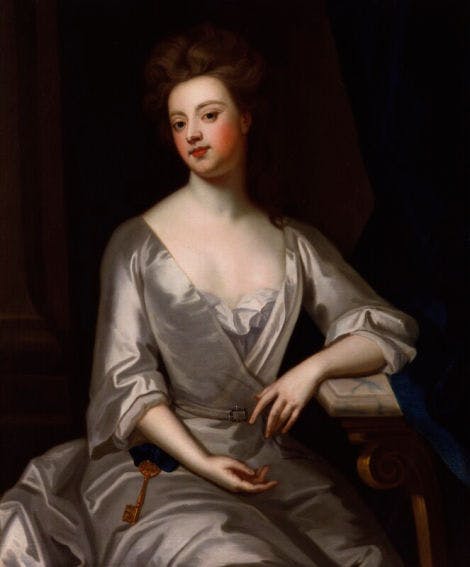
Image: Sarah Churchill (née Jenyns (Jennings)), Duchess of Marlborough after Sir Godfrey Kneller, Bt. © National Portrait Gallery, London
'Dark deeds at night'
Sarah's arrogance contributed to her downfall, and Queen Anne grew close to Sarah’s cousin Abigail Masham. Abigail had the gentle character that the emotionally vulnerable Anne needed. A wife and mother, Queen Anne suffered from poor health, and many of her pregnancies ended in miscarriage or stillbirth.
We will never know what Queen Anne’s private relationships with Sarah and Abigail were, but in 1708 Sarah betrayed Anne’s trust. Sarah’s secretary Arthur Mainwaring, circulated political pamphlets against the Queen, talking of the ‘sweet service’ and ‘dark deeds at night’ between Anne and Abigail.
Anne and Sarah had a terrible, final argument in the Queen’s Apartments at Kensington Palace in 1710, after which they never spoke again.
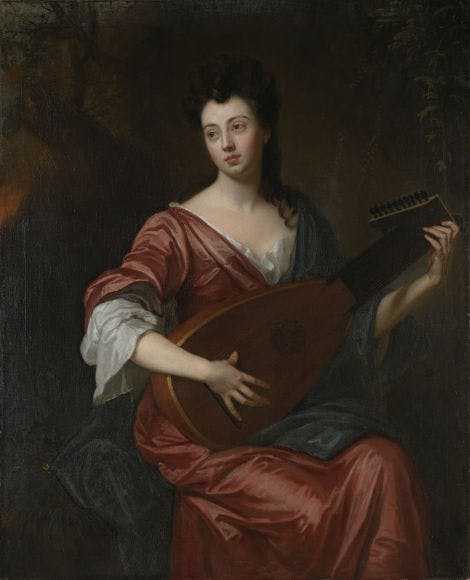
Image: Arabella Hunt (1662-1705) Playing a Lute by Godfrey Kneller, © Government Art Collection
Love in the royal court: Arabella Hunt
Arabella Hunt (1662–1705) was a gifted musician who served at the court of Queen Mary II and taught Queen Anne to sing.
Arabella’s voice was described as ‘like the pipe of a bullfinch’, she could accompany herself beautifully on the lute and was hugely popular with the public.
Arabella married James Howard on 12 September 1680 and they lived together for six months in Arabella’s mother’s house. However, James was a woman called Amy Poulter, who dressed in male clothes, and had courted Arabella dressed as a man and as a woman. Amy was also married to a man called Arthur Poulter when she married Arabella.
'Under suspicion of being one of a double gender'
When Arabella went to court to have the marriage annulled, the court needed to determine whether Amy was a woman or of ‘double gender (being usually called an hermaphrodite)’. A team of midwives determined that she was a 'perfect woman in all her parts'.
We will never know what Arabella and Amy really knew or felt. Did Amy dress as a man because she identified as male, because she was attracted to women, or to enjoy the social status men had?
Did you know?
Women sometimes dressed as men to access male environments like the army, or to travel in safety.
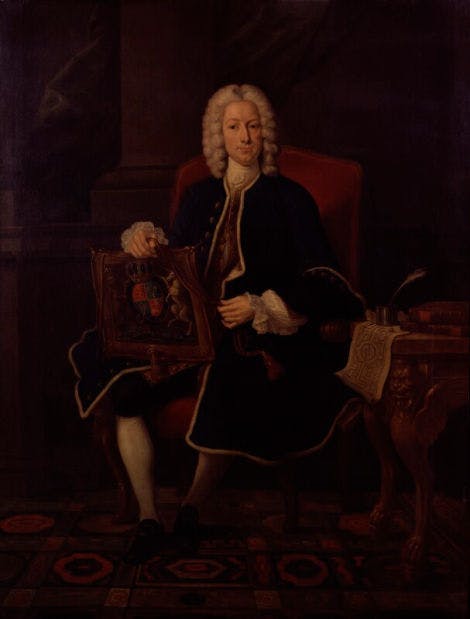
Image: John Hervey, Baron Hervey of Ickworth, © National Portrait Gallery, London.
Lord Hervey
In the 18th century the way people understood same-sex desire and the people who experienced it changed radically.
As the century progressed same sex desire began to be understood not as something many people did, but as something that was fundamental to the identity of a few people. The century saw the rise of ‘mollies’, a sub-culture of men whose effeminate mannerisms and clothes were related to their same-sex desire.
The courtier John Hervey (1696-1743), 2nd Baron Hervey, was criticised for his effeminate appearance and manner, with contemporary wits calling him an ‘amphibious thing’ and claiming that people were divided into ‘men, women, and Herveys’.
As a close friend of Queen Caroline, consort of George II, Hervey knew the public and private apartments of Hampton Court Palace and Kensington Palace well.

Image: Frederick Louis, Prince of Wales by Philip Mercier. © National Portrait Gallery, London
'He makes our lives a delight'
John Hervey married a great beauty of the court, Molly Lepell in 1720, but had romantic relationships with men and women.
He had a 14-year relationship with the nobleman Stephen ‘Ste’ Fox, and they lived together in Italy and exchanged passionate letters. Writing about Ste Fox, Lord Hervey said, 'He makes our lives a delight, Laughing, chatting, singing and scaring boredom away.'
Hervey's relationship with Frederick, Prince of Wales, was very close, although any evidence for its true nature has been destroyed.
Royal servants and the household
Many lives have left no trace in the historical record, and this is especially true for queer lives and stories. Same-sex love may have had to be hidden, and before civil-partnerships and same-sex marriage, left no legal records. Before the decriminalisation of sex between men, information about sexual encounters sometimes finds it way into legal records, but the same is not true of sex between women.
Occasional records of cross-dressing survive, and there are plenty of stories of ‘passing women’ who dressed as men and lived male lives, including fighting as soldiers. Yet how many people were never discovered or noticed? Some same-sex love and desire may have been so ordinary that it wasn’t worth recording, something you did occasionally, or early in your life before marriage.
Did you know?
Sharing beds with people of the same sex was normal, even for masters and servants and strangers when travelling, so many people would have had the opportunity for same-sex intimacy every day.
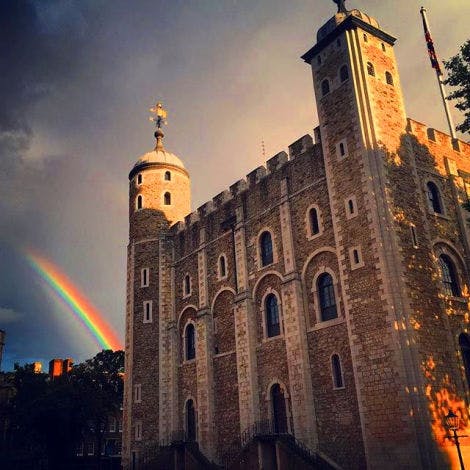
The White Tower with a rainbow in the background © Historic Royal Palaces
Remembering forgotten lives
Palaces and royal courts need many people to run. Hundreds of people prepared food, served courtiers, washed clothes, cleaned, cared for horses and worked to build and maintain vast buildings and estates.
The Tower of London (pictured) has been a palace, prison and home to the army for centuries. At Hampton Court Palace today you can visit Henry VIII's Kitchens, once staffed by a huge number of servants, and visitors buy their tickets in the Barrack Block, home to the soldiers who protected William III.
It is too easy to assume that everybody in the past was straight unless we have clear proof otherwise, but we know this is not the case. Next time you visit one of our palaces think about all of the lives lived within its walls and all the different ways people have lived and loved through history.
Listen to the podcast
LGBTQ+ History: Queer Possibilities at Our Palaces
LGBTQ+ people have always existed in the history of our palaces, yet the stories of this community have often been obscured or misunderstood. When we explore queer histories, we gain a much fuller picture of societies in the past, from when our palaces were first built, right on through to their more recent history.
In this episode of the Historic Royal Palaces podcast, Curator Matthew Storey is joined by Assistant Research Curator Holly Marsden, and Dr Kit Heyam. They discuss some queer stories connected to our palaces, and how best to understand them in their historic context.
In this episode, we use a range of different gender pronouns to discuss historical people, including those used in the original sources and those used by historians today.
Content warning
This episode includes discussion of homophobia, including the murder of queer people; transphobia; non-consensual medical examination; and suicide.
More episodesPodcast Transcript

Frederick Wright Or Kathleen Woodhouse: A First World War Soldier Who Wished To Live As A Woman
February is LGBT+ History Month in the UK, which aims to increase the visibility of lesbian, gay, bisexual and trans (LGBT+) people through the exploration of their history and stories. Collections Curator Matthew Story explores one such story.

The Real Norman Hartnell: Beyond 'Silver and Gold'
February is LGBT+ History Month in the UK, which aims to increase the visibility of lesbian, gay, bisexual and trans (LGBT+) people through the exploration of their history and stories. Collections Curator Matthew Storey looks at one such story.

A Queer Walk through Hampton Court Palace
When you next visit Hampton Court, bring a queer eye to the palace. Shift your perception. Actively look around you. I promise there is a rich history to find.
Browse more history and stories
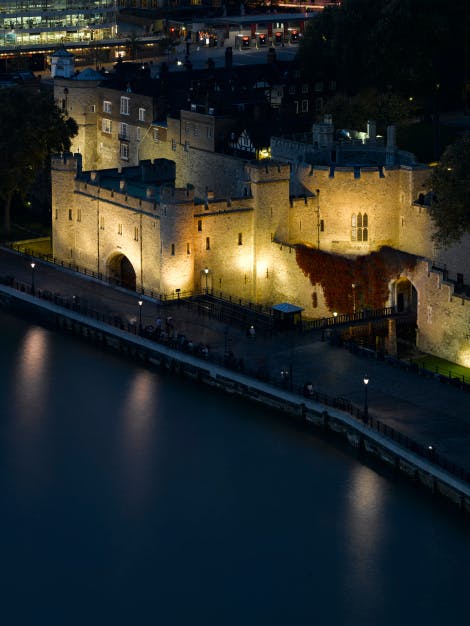
The story of the Tower of London
Iconic fortress, royal palace and infamous prison.

Guy Fawkes and the Gunpowder Plot
Who was the real Guy Fawkes, the man behind the mask?
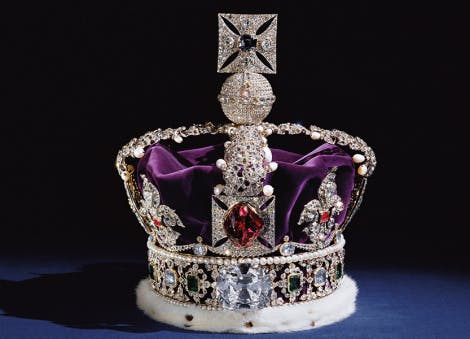
The Crown Jewels
The history of the Crown Jewels, including the Imperial State Crown - a priceless collection used to crown the kings and queens of England.
Explore what's on

- Things to see
White Tower
Marvel at the imposing White Tower, a magnificent example of Norman architecture at the heart of the Tower of London.
-
Open
- Tower of London
- Included in palace admission (Members go free)

- Things to see
Imprisonment at the Tower exhibition
Learn why people ended up as prisoners in the Tower of London, in the very rooms where some of them were held.
- Open
- Tower of London
- Included in palace admission (Members go free)

- Things to see
- Tours and talks
Yeoman Warder tours
Tour the Tower of London with a famous Yeoman Warder during your visit. Be entertained by tales of intrigue, imprisonment, execution, torture and much more...
-
Daily
- Tours begin every 45 minutes
- Tower of London
- Included in palace admission (Members go free)
Shop online
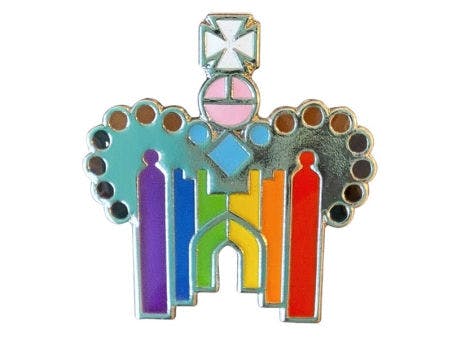
Crown Pride Pin Badge
This pride pin badge is exclusively available from Historic Royal Palaces and shows our logo in the vibrant colours of the rainbow.
£3.00

Shop Crown Jewels
For centuries, the Tower of London has safeguarded and showcased the illustrious Crown Jewels, discover our range inspired by these majestic objects.
From £2.50

White Tower Decoration
This sparkling silver luxury White Tower hanging decoration is hand embroidered using the same metal thread work techniques used to sew royal dresses and finery in centuries past.
£13.00
